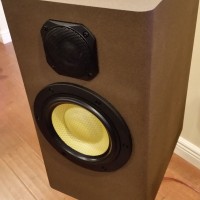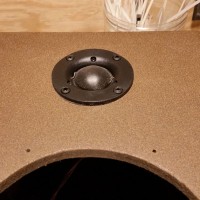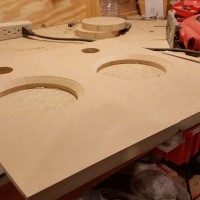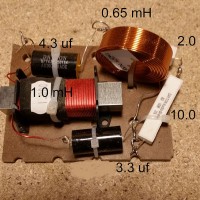
Simplicity
Designer:
Eric L. “brkitup”
Project Category:
Bookshelf Speakers
Project Level:
Beginner
Project Time:
8-20 Hours
Project Cost:
$100 – $500
Project Description:
Simplicity is a two-way bookshelf loudspeaker system using Dynavox and Dayton drivers, and knock-down flat-pack speaker cabinets.
Design Goals:
The goal of this project was to make a high-performance bookshelf speaker that could handle decent power, was simple in design and construction, and would provide exceptional sound quality for the money.
Driver Selection:
I’ve always wanted to use a Dynavox driver, so when the new series was introduced, I knew it was time to pull the trigger. I ended up choosing the Dynavox LW6004HR-N (295-626) 6.5″ woofer for its fairly smooth response and roll-off characteristics, and also because it’s gorgeous to look at. For the tweeter I chose the Dayton ND28F-6 (275-040), which is a proven performer and a great value.
Enclosure Design:
The enclosure is the .56 cu. ft. Denovo flat-pack speaker cabinet. These are CNC-cut, which makes construction quite simple. The Dynavox woofers are fairly high-Q units, and therefore work well in moderately-sized sealed enclosures. Calculations revealed the woofers would have an F3 of 66Hz, which is quite good for a sealed alignment.
Enclosure Assembly:
Enclosure assembly was a simple affair. I used a combination of wood glue, brads, and clamps during construction. Because the enclosure panels were pre-cut, a lot of time was saved in the assembly and construction process.
Crossover Design:
I enjoy using drivers with smooth roll-off characteristics in their frequency response, because it greatly simplifies crossover design. Because both the Dynavox woofer and Dayton tweeter were so well-behaved in this regard, I was able to use a simple 2nd-order Linkwitz-Riley alignment, and achieve excellent results. The woofer already has a slight downward-sloping response that was increased by using a slightly higher than required inductor on the woofer. This caused the response to slope downward slightly more, which is useful for correcting what’s known as “baffle-step”, and allows the speaker to produce more even frequency response when placed in a room. The crossover point I chose was 3 kHz, which places very little stress on the tweeter, and also works well for the Dynavox woofer.
Tips & Tricks:
I used a textured spray paint for the finish, but veneer would work also. To protect the tweeter I used the Visaton speaker grill (292-526) that was designed for 2.5″ speakers. It works perfectly for covering the tweeter, especially if you choose not to flush-mount. It is recommended that you use some sort of “fill” in the enclosure to minimize standing waves. I recommend using egg-crate style foam.
Conclusion:
This project exceeded my expectations. I wanted to create an economical bookshelf speaker that sounded good with a wide range of music. What I ended up with is the best speaker I’ve built thus far.
About the Designer:
I am a stay-at-home foster father, and have been building speakers for twenty years. I am also the sound engineer for The Foundation Church in Norwalk, Ohio.
Project Parts List:





do you have a FR chart for this? im looking in to building something like it.
I’d like to give your design a try, but I’m having a hard time interpreting the XO. I’m not familiar enough with passive filter networks to reverse engineer the picture. If you could post a diagram, I’d be grateful!
Is there a reason the tweeter is connected – + on the crossover diagram?